Section 1: Agency overview and resources
1.1 Strategic direction
The outcome of the Inspector-General of Taxation (IGT) is improved tax administration through community consultation, review and independent advice to government.
IGT's strategic direction for 2011-12 is to improve review processes, timeliness and outcomes by:
- expanding opportunity for community input;
- continuing to build on approaches that increase the Australian Taxation Office's (ATO) involvement and contribution to review processes and outcomes; and
- continuing the appropriate use of external expertise and overseas comparisons to enhance capabilities and objectivity.
In 2010-11, the IGT established a new work program for 2011-12 through a broad-based community consultation process which remains in effect for the 2011-12 year.
1.2 Agency resource statement
Table 1.1 shows the total resources from all sources. The table summarises how resources will be applied by outcome and by departmental classification.
Table 1.1: Inspector-General of Taxation resource statement — Budget estimates
for 2011-12 as at Budget May 2011
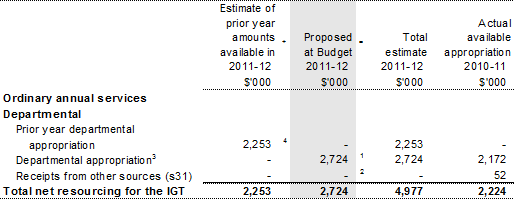
1. Appropriation Bill (No. 1) 2011-12.
2. Receipts received under s31 of the Financial Management and Accountability Act 1997.
3. Includes $0.04 million in 2011-12 for the departmental capital budget (refer to Table 3.2.5 for further details).
4. Estimated adjusted balance carried from previous year for annual appropriations.
1.3 Budget measures
Budget measures relating to the IGT are detailed in Budget Paper No. 2, Budget Measures 2011-12 and are summarised below.
Table 1.2: Inspector-General of Taxation 2011-12 Budget measures
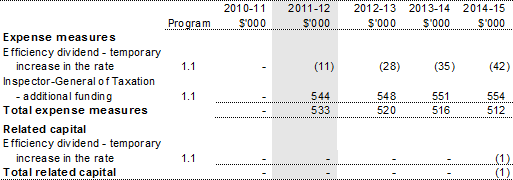
Prepared on a government finance statistics (fiscal) basis.
Section 2: Outcomes and planned performance
2.1 Outcomes and performance information
Government outcomes are the intended results, impacts or consequences of actions by the Government on the Australian community. Commonwealth programs are the primary vehicle by which government agencies achieve the intended results of their outcome statements. Agencies are required to identify the programs which contribute to Government outcomes over the budget and forward years.
The IGT's outcome is described below specifying the strategy, program, objective, deliverables and key performance indicators used to assess and monitor the performance of the IGT.
Outcome 1: Improved tax administration through community consultation, review, and independent advice to government.
Outcome 1 strategy
Key strategies to achieve Outcome 1 are:
- undertake community consultation, research and other processes to identify and prioritise areas of tax administration that can be systemically improved;
- call for submissions to review and to stimulate input by, for example, issuing terms of reference and similar materials;
- review identified areas and provide independent advice and recommendations to the Government on improvements to the administration of the tax laws;
- maintain a positive public profile for the IGT through participation in conferences and seminars;
- build on approaches that increase the ATO's involvement and contribution to review processes and outcomes; and
- selectively engage external expertise and undertake overseas comparisons to enhance capabilities and objectivity for appropriate reviews.
The major projects and activities expected to be commenced and/or completed during 2011-12 include:
- review of the ATO's implementation of the Report on Aspects of Income Tax Self Assessment recommendations;
- review into the ATO's use of benchmarking to target the cash economy;
- review into the ATO's use of Early and Alternative Dispute Resolution;
- review into the ATO's small and medium enterprise audit and risk review policies, procedures and practices; and
- follow-up review into the ATO implementation of IGT recommendations.
Outcome expense statement
Table 2.1 provides an overview of the total expenses for Outcome 1.
Table 2.1: Budgeted expenses for Outcome 1
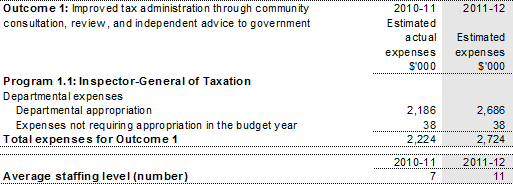
Contributions to Outcome 1
Program 1.1: Inspector-General of Taxation
Program objective
The IGT has the following objectives:
- identify areas of the tax system's administration where the community or other stakeholders believe that improvements should be made or issues reviewed;
- consult with government agencies that review tax administration, in particular the Australian National Audit Office and the Commonwealth Ombudsman to foster cooperation and make efficient use of resources;
- prioritise areas of tax administration for review according to the IGT's work program and ministerial direction as appropriate;
- provide independent advice to the Government on the tax system's administration and make recommendations on improvements; and
- follow-up on the ATO's implementation of IGT recommendations.
Program expenses
The increase in expenses in 2011-12 and forward years relates to additional funding for the IGT as detailed in Budget Paper No. 2, Budget Measures 2011-12.
Table 2.2: Program expenses

Program deliverables
The IGT has the following deliverables:
- a program of reviews based on community input and consultation with other relevant agencies, and prioritised in line with principles of good tax administration; and
- six completed reviews incorporating independent advice to the Government on systemic issues and/or viable improvements to tax administration.
Program key performance indicators
The IGT has the following key performance indicators:
- positive feedback and continued support from community stakeholders including taxpayers, tax practitioners and relevant government agencies; and
- recommendations for systemic improvements in tax administration agreed and implemented by the ATO and/or the Government.
Section 3: Explanatory tables and budgeted financial statements
Section 3 presents explanatory tables and budgeted financial statements which provide a comprehensive snapshot of agency finances for the 2011-12 budget year. It explains how budget plans are incorporated into the financial statements and provides further details of the reconciliation between appropriations and program expenses, movements in administered funds, special accounts and government Indigenous expenditure.
3.1 Explanatory tables
3.1.1 Movement of administered funds between years
The IGT has no administered funds.
3.1.2 Special accounts
The IGT has no special accounts.
3.1.3 Australian Government Indigenous Expenditure
The IGT has no Australian Government Indigenous Expenditure.
3.2 Budgeted financial statements
3.2.1 Differences in agency resourcing and financial statements
There are no differences between agency resourcing and financial statements.
3.2.2 Analysis of budgeted financial statements
The IGT is budgeti
ng for a break-even operating result in 2011-12 after adding back non-appropriated depreciation and amortisation expenses.
3.2.3 Budgeted financial statements tables
Table 3.2.1: Budgeted departmental comprehensive income statement
(for the period ended 30 June)
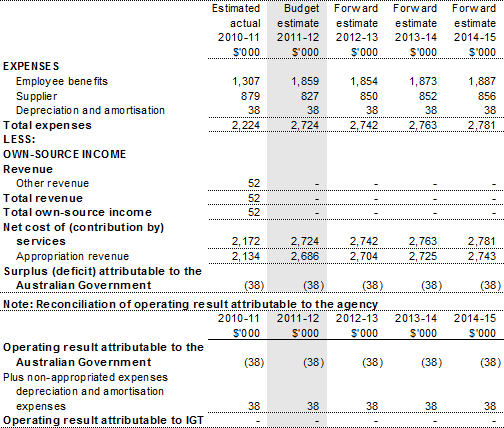
Prepared on Australian Accounting Standards basis.
Table 3.2.2: Budgeted departmental balance sheet
(as at 30 June)
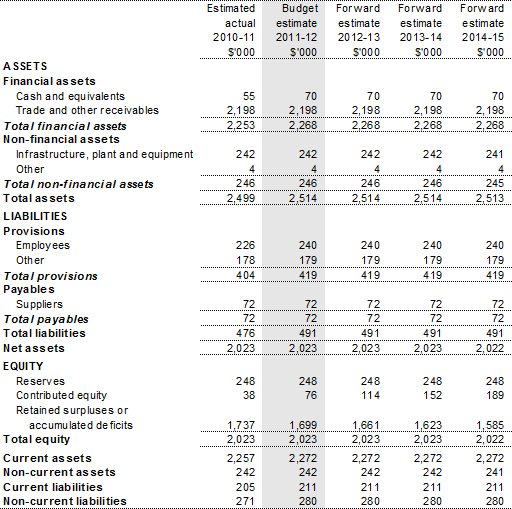
Prepared on Australian Accounting Standards basis.
Table 3.2.3: Budgeted departmental statement of cash flows
(for the period ended 30 June)
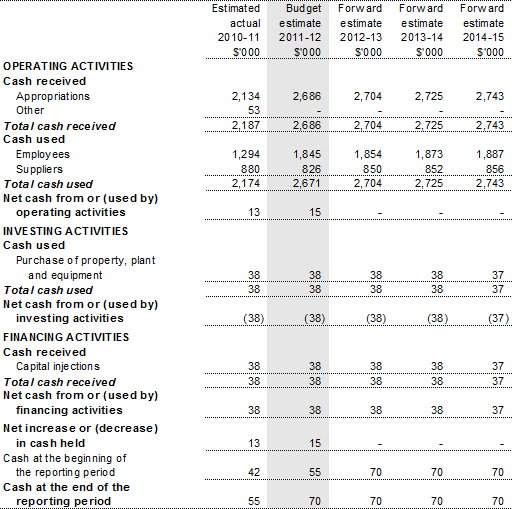
Prepared on Australian Accounting Standards basis.
Table 3.2.4: Departmental statement of changes in equity — summary of
movement (budget year 2011-12)
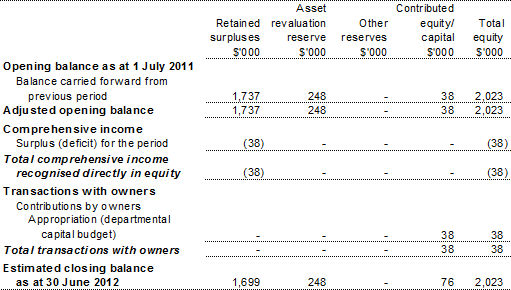
Prepared on Australian Accounting Standards basis.
Table 3.2.5: Departmental capital budget (DCB) statement
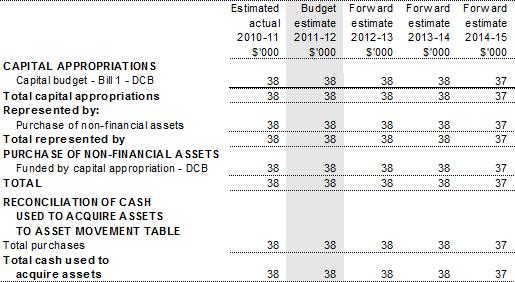
Prepared on Australian Accounting Standards basis.
Table 3.2.6: Statement of asset movements — departmental
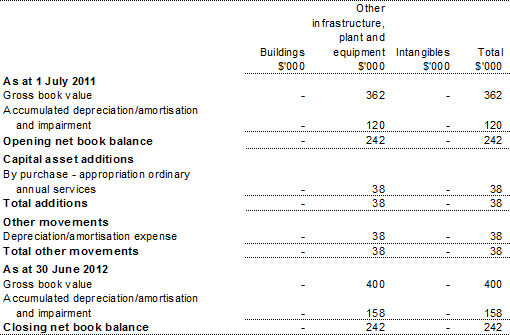
Prepared on Australian Accounting Standards basis.
3.2.4 Notes to the financial statements
The financial statements have been prepared on an Australian Accounting Standards basis.